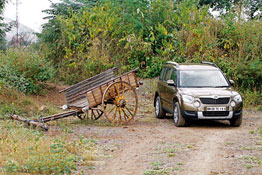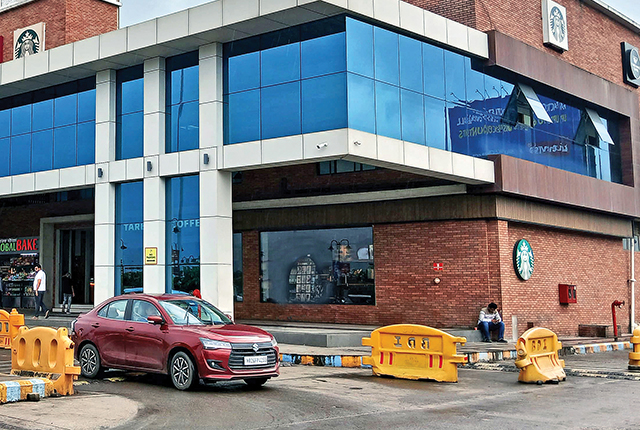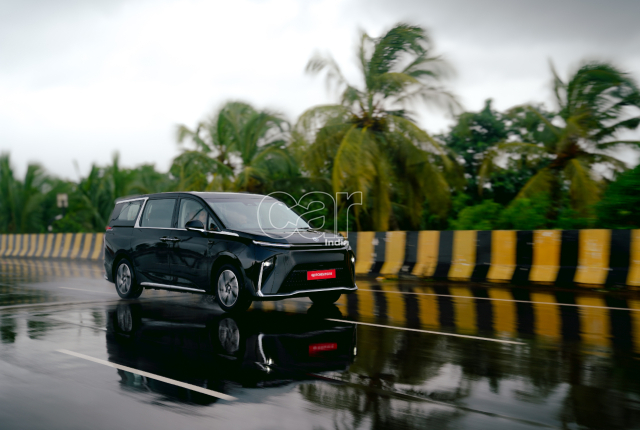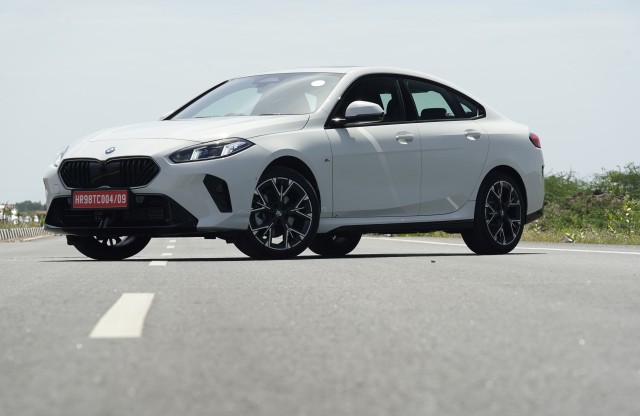
 Off to the next location. As I get in and shut the door, I get that ever so pleasing ‘thud’, which reaffirms its quintessential Czech lineage. Once inside, the Yeti looks more sedan-like, as the steering wheel and instrument console resemble the ones in the Laura and are made of equally good quality material. It has a typical Skoda dashboard and central console and the upper and lower dash divided by artificial Boreal wood trims which look really neat. True to its lineage, the front seats are large and offer the optimum support and comfort. The rear portion of the SUV is very cleverly designed. The rear seats offer plenty of thigh support, the tall design accentuates cabin room and even taller people can sit comfortably. Each of the three rear seats can tumble or even be removed completely to enhance the luggage space. Skoda’s VarioFlex allows two of side rear seats to move backward, forward and even sideways. Chuck out the centre seat from the rear and make the car a four-seater by sliding the remaining two rear seats directly behind the front ones. The 416 litres of luggage space is not bad either, which is covered by a large parcel tray. You get runners on the two sides with plenty of hooks to latch your rucksacks and other trekking equipment on.
Off to the next location. As I get in and shut the door, I get that ever so pleasing ‘thud’, which reaffirms its quintessential Czech lineage. Once inside, the Yeti looks more sedan-like, as the steering wheel and instrument console resemble the ones in the Laura and are made of equally good quality material. It has a typical Skoda dashboard and central console and the upper and lower dash divided by artificial Boreal wood trims which look really neat. True to its lineage, the front seats are large and offer the optimum support and comfort. The rear portion of the SUV is very cleverly designed. The rear seats offer plenty of thigh support, the tall design accentuates cabin room and even taller people can sit comfortably. Each of the three rear seats can tumble or even be removed completely to enhance the luggage space. Skoda’s VarioFlex allows two of side rear seats to move backward, forward and even sideways. Chuck out the centre seat from the rear and make the car a four-seater by sliding the remaining two rear seats directly behind the front ones. The 416 litres of luggage space is not bad either, which is covered by a large parcel tray. You get runners on the two sides with plenty of hooks to latch your rucksacks and other trekking equipment on.

 Time for the engine shot. I popped the bonnet to see what lay beneath. The familiar 1,986-cc DOHC diesel engine featuring turbocharger, common-rail and 16 valves powers the Yeti too. The potent motor has been tuned to churn out 142 PS at 4,200 rpm and 320 Nm of max torque, which comes into play between 1,750 and 2,500 rpm. Mated with a six-speed manual transmission, the SUV uses a Haldex full-time four-wheel-drive system. While driving on normal road conditions it functions like a regular front-wheel-drive car and close to 95 per cent of the motor’s power is transferred to the front wheels. And if it detects any slip, then more power is transferred to the rear wheels. This system can transfer up to 90 per cent of power to the rear wheels if the need arises and also features a limited slip differential. The independent McPherson suspension, 180 mm of ground clearance and the Haldex 4×4 add up to make the Yeti a decent off-roader.
Time for the engine shot. I popped the bonnet to see what lay beneath. The familiar 1,986-cc DOHC diesel engine featuring turbocharger, common-rail and 16 valves powers the Yeti too. The potent motor has been tuned to churn out 142 PS at 4,200 rpm and 320 Nm of max torque, which comes into play between 1,750 and 2,500 rpm. Mated with a six-speed manual transmission, the SUV uses a Haldex full-time four-wheel-drive system. While driving on normal road conditions it functions like a regular front-wheel-drive car and close to 95 per cent of the motor’s power is transferred to the front wheels. And if it detects any slip, then more power is transferred to the rear wheels. This system can transfer up to 90 per cent of power to the rear wheels if the need arises and also features a limited slip differential. The independent McPherson suspension, 180 mm of ground clearance and the Haldex 4×4 add up to make the Yeti a decent off-roader.
 The on-road abilities are no less either as the SUV remains grounded even at high speed and there is hardly any body roll. The linear torque kicks in early and continues to the mid-range, which also makes it quite fuel-efficient with an overall figure of 14 km per litre. The TDI can be revved all the way up to 5,000 rpm, which is more than necessary for a torquey mill like this.
The on-road abilities are no less either as the SUV remains grounded even at high speed and there is hardly any body roll. The linear torque kicks in early and continues to the mid-range, which also makes it quite fuel-efficient with an overall figure of 14 km per litre. The TDI can be revved all the way up to 5,000 rpm, which is more than necessary for a torquey mill like this.
The steering is quite accurate and the suspension is on the firmer side without being too harsh. The responsive two-litre motor makes driving the Yeti a fun experience even on the highway. The compact size makes great sense in the city and the tall-boy design gives a good all-round visibility. The parking sensors make parking the SUV even in tight spots an easy task. The front fog lamps with the corner function detect when the car is turning and automatically focus on the area providing better illumination on the curve. Fabulous!
 Honestly, there are a couple of things that disappointed me about the SUV. Firstly, Skoda have not yet offered an automatic transmision on it and, secondly, its price. Yeti is offered in two variants – the Ambiente at Rs 17.73 lakh (OTR, Pune) and the fully loaded Elegance trim at Rs 19.30 lakh (OTR, Pune) – whereas I expected the compact five-seater to cost about Rs 15 lakh. The extras that you get in the Elegance are better looking dashboards with the Boreal wood trim, side and curtain air bags, 6.6 inch touch screen LCD and a six CD changer, audio controls on the steering wheel, climate control, hill descent controls, front and rear park sensor (the Ambiente gets just rear sensors) and auto dimming ORVM. Unlike the white snowman, the Skoda Yeti is available in six body colours and both variants get leather upholstery and 16-inch 215/60 R16 tyres.
Honestly, there are a couple of things that disappointed me about the SUV. Firstly, Skoda have not yet offered an automatic transmision on it and, secondly, its price. Yeti is offered in two variants – the Ambiente at Rs 17.73 lakh (OTR, Pune) and the fully loaded Elegance trim at Rs 19.30 lakh (OTR, Pune) – whereas I expected the compact five-seater to cost about Rs 15 lakh. The extras that you get in the Elegance are better looking dashboards with the Boreal wood trim, side and curtain air bags, 6.6 inch touch screen LCD and a six CD changer, audio controls on the steering wheel, climate control, hill descent controls, front and rear park sensor (the Ambiente gets just rear sensors) and auto dimming ORVM. Unlike the white snowman, the Skoda Yeti is available in six body colours and both variants get leather upholstery and 16-inch 215/60 R16 tyres.
The Yeti is another feature-packed and well-built vehicle from the Skoda stable, which with its unique positioning will be equally well accepted by Indian consumers. A capable machine that’s good for city use and can also take you up the Himalayas in search of the other Yeti.
CAPTIONS:
1. The hill decent system works well while off-roading, while park assist and EPS are a blessing in cities and highways.
2. The typical Skoda dashboard is divided by artificial Boreal wood trims which look really neat.
3. The 1,986-cc DOHC diesel engine mated with a six-speed manual transmission and permanent 4×4 make the Yeti an able SUV
4. The rear seat arrangement is very flexible as they can be moved backward, forward and sideways, and can also be removed individually to increase storage space.






















Leave a Reply